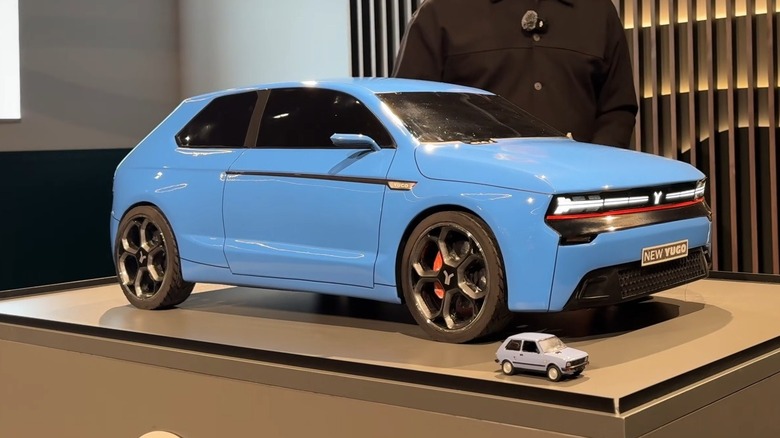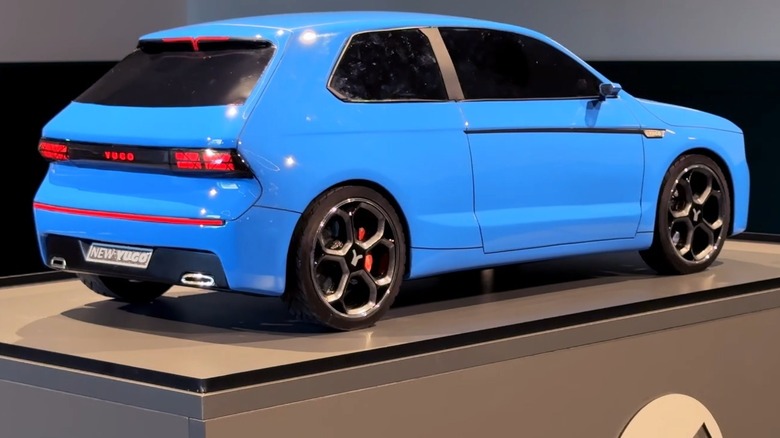Is The Yugo Car Coming Back? Here's What We Know (And What It Could Look Like)
Few cars evoke a sense of truly barebones motoring like a Yugo. Sometimes cited as the worst car in history and the most hated car ever sold in the United States, the fundamental philosophy of the Yugo is to provide a set of wheels as cheaply as possible, often to the exclusion of basic creature comforts. For context, the original Yugo debuted on the U.S. market for $3,990 with a $389 destination charge. Adjusted for inflation, this equals about $13,000 USD in 2025 including fees — that's roughly 25% cheaper than the current cheapest car in America, the Nissan Versa. The original Yugo lasted a mere eight model years stateside, being discontinued in 1992 largely as a result of the Yugoslavian Civil War, though its legacy continued as a laughingstock of automotive culture.
It surprised everyone, then, when Yugo announced its return in February 2025, utilizing a similar template to its ancestor. This was confirmed by a report to Autopian, which states that Professor Dr. Aleksandar Bjelić acquired the rights to the Yugo name and began early design work on a modernization of the Cold War classic. This new car, penned by Serbian designer Darko Marčeta, appears as a two-door hatchback emulating the original Yugo's design characteristics — namely, a boxy appearance and compact stance. Over the past several months, sketches turned into reality, and now we have a proper scale model to analyze. Let's discuss the Yugo and its quirky history, and what we're likely to see in the future when the prototype debuts.
Yugoslavia's interpretation of the people's car
Despite seemingly disappearing overnight, the Yugo actually enjoyed a long and profitable production run, beginning in 1980 as the Zastava Koral and lasting until November 11, 2008, with a respectable 794,428 cars built. Of those, 141,651 made it stateside, equipped with either a 1.1L and 4-speed manual, or a 1.3L and 5-speed or optional 3-speed automatic. While most people know it as simply "Yugo," the American-spec car's full name is actually "Zastava Yugo GV," the "GV" meaning "Good Value."
Zastava produced a variety of vehicles during the Cold War, beginning in 1954 with several Fiat models built under license. The Yugoslav automotive economy suffered heavily throughout the 1970s as a result of the ongoing oil crisis and the government's policies, necessitating the creation of a small, practical, and incredibly cheap car. Zastava again partnered with Fiat to build such a vehicle, basing it on a Fiat 127, with early prototypes available in 1978. The car was ultimately named Yugo (or Jugo) 45 and launched in October 1980 at the Belgrade Motor Show, and Zastava began exporting the car's derivatives internationally within several years.
Malcolm Bricklin, a man widely known for importing small cars into the United States, originally imported the Yugo into the United States in 1985, marketing it as the Yugo Good Value. It replaced the Chevy Chevette as the cheapest economy car in America, banking off its price to help shift sales. Bricklin ultimately sold his share in 1988 for $20 million, a hefty sum for a name that people love to hate.
Return of the Yugo
Zastava Automobili produced its last car on November 21, 2008, with its assets absorbed into Fiat. The company subsequently declared bankruptcy less than a decade later, leaving the fate of the Yugo in limbo until 2025, culminating in the ongoing project to resurrect the brand.
Darko Marčeta's design, as interpreted in the scale-model representation, appears as a retro-futuristic 2-door hatchback in the style of the stereotypical American Yugo. Proportionately, it evokes traditional, boxy, practical styling cues but features prominent curving along the rear pillars, reminiscent of vehicles like a Lada Riva without the SUV components. It's a fitting design for a concept based on one of the cheapest production cars ever made.
As for powertrain options, the modern Yugo will apparently boast far greater variety than it ever had, with options for naturally aspirated or turbocharged combustion powerplants, plus a bonus EV configuration. It'll also feature either an automatic or manual transmission, becoming one of a dwindling number of new cars offered with a stick-shift. The company even hinted at a performance-oriented version, not something typically spoken in the same breath as "Yugo." Further details remain scant, however; virtually all of these statements represent an ongoing project and are naturally subject to change. Similarly, while the Yugo trademark was resurrected, there isn't much actual concrete evidence of the car's existence beyond press releases, hearsay, photographs of sketches, and the scale model showcased at the Munich Car Design Event 2025. Regardless, a turbocharged 5-speed manual hot hatch in 2027 sounds like a real treat to drive, no matter what badge it wears.


